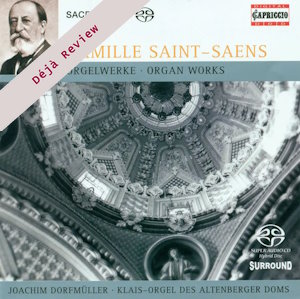
Déjà Review: this review was first published in August 2005 and the recording is still available.
Camille Saint-Saëns (1835-1921)
Organ Works
Prelude and Fugue in E flat major Op.99 No.3 (1894)
Elevation ou communion in E flat major (1865)
Benediction nuptiale Op.9 (1868)
Fantaisie in E flat major (1857)
Fantaisie in D flat major Op.101 (1895)
Improvisation in E flat major Op.150 No.1 (1917)
Improvisation in C major Op.150 No.7 (1917)
Joachim Dorfmuller (organ) (Klais, 1980)
rec. 1985, Altenberg Cathedral, Germany
Capriccio 71046 SACD [53]
Technically this recording caused déjà vu for the bad old days of the sixties and seventies when old mono recordings were re-processed, often badly, into stereo. This is very probably a stereo recording which has been remixed for 5.1 surround. No significant surround results. There is a weak middle channel and as far as I could tell no ‘point one’ channel either which is silly for an organ recording. I got the best results by playing the CD layer of this hybrid disk and switching the bass to my sub-woofer. The result was much better organ sound than the so-called high resolution layer. No marks to Capriccio for that.
Having got that off my chest, this is a splendid organ with a good range of colours for this attractive music. Saint-Saëns was a keyboard musician all his life – he started the piano at two and a half, no wonder some of the concertos are of such fiendish difficulty – and became the official organist of a Parisian church at just 18 years old. Though he did not remain an organist as such beyond about 1877, aged 42, he remained devoted to the instrument and wrote works of great technical challenge, the E flat Prelude and Fugue and the Fantaisie in D flat major both of 1895 for example are both virtuoso works. It is worth noting that the later pieces Op.117 (the set of seven Improvisations), even strayed into impressionist territory.
The Elevation ou Communion is a rather beautiful slow piece. The prettiness of the Benediction was slightly spoiled by a very noisy organ blower in the quiet passages. The second of the two Fantaisies is a much more large-scale piece in several sections and with a touching quiet close. The last two tracks are confusingly called Improvisation, the first is contemplative with some lovely deep pedal work (but see above) and the second is lively and showy and draws this enjoyable recital to a conclusion.
The notes are simply a biographical summary with an appreciation of Saint-Saëns and just a few lines on the organ music with no details and no dates – the dates above are taken from Grove. Despite my technical reservations Saint-Saëns enthusiasts should not hesitate to add this attractive disc to their collections and others might do well to try it out. Saint-Saëns is an extraordinary figure insofar as most of his output is very fine, even though most of it is also unplayed. Finding a dud piece deserving neglect is about as difficult as finding poor music by Martinů or indeed by Vivaldi. We would do well to keep our musical blinkers off!
Dave Billinge
Buying this recording via a link below generates revenue for MWI, which helps the site remain free



















